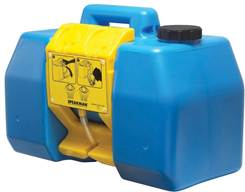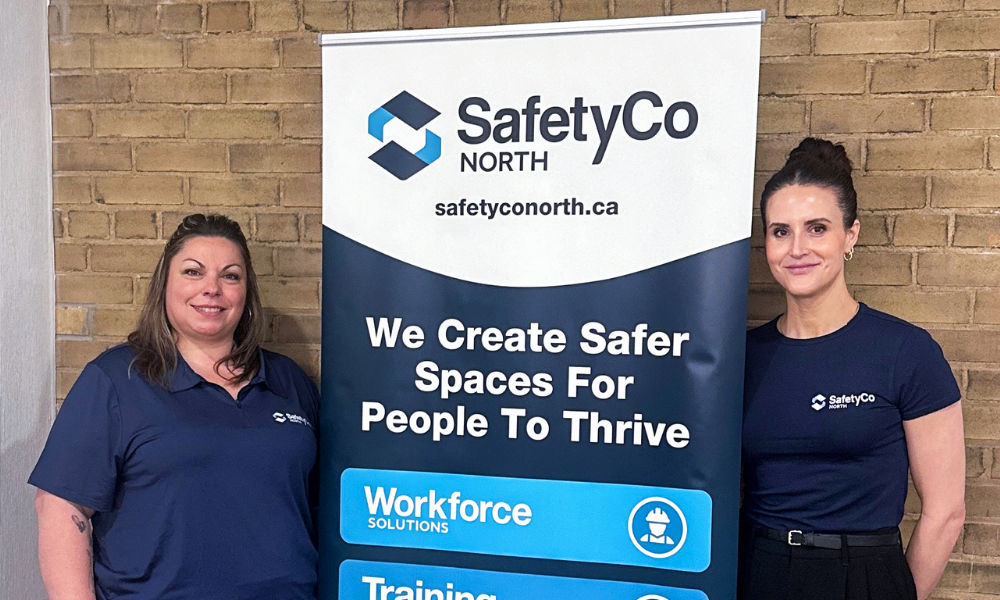In industrial settings and worksites, eyewash stations are integral to workplace safety. Get to know more about eyewash stations in this guide
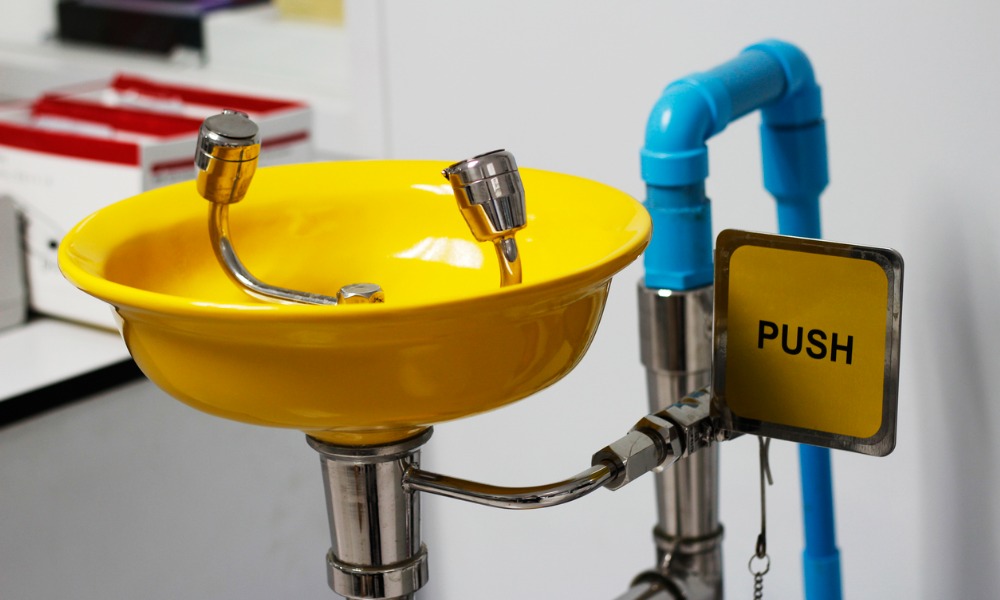
- The best eyewash stations for your workforce
- What are the different types of eyewash stations?
- Key features to consider in eyewash stations
- Eyewash station compliance requirements
- Eyewash station installation tips
- Eyewash station options
- Maintenance and testing of eyewash stations
- Guidelines for using eyewash stations
- The importance of eyewash stations
There’s a significant number of eye injuries daily on the job, especially in industrial work areas where employees can be exposed to harmful chemicals or substances, dirt, or debris. Fortunately, with proper care and the right personal protective equipment, 90 percent of these injuries are preventable.
In this article, Canadian Occupational Safety discusses the need for emergency eyewash stations. If your organization has yet to include eyewash stations as part of your safety measures, this guide on eyewash stations should help. We will also provide a list of the best eyewash stations for industrial worksites, so let's dive in.
The best eyewash stations for your workforce
Here’s a list of some of our top choices for eyewash stations on the market. You and your staff can explore these options, but it’s best to shop around and compare before finalizing purchase decisions.
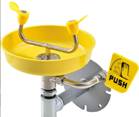
1. Wall-mounted eyewash station top pick: Global Industrial Emergency Eye Wash Station
Price range: $654.40 to $823.07
This model is our top choice because of its robust materials. Its plastic bowl mounts directly onto a wall, maximizing its stability and durability. With its dual head spray system, automatic flow control and integral flow control, this unit can provide a gentle water flow that won’t cause further irritation and ensures thorough flushing.
The unit is easily activated by a visible push plate, so eye flushing is done quickly. This is ideal for worksites that deal with many hazardous chemicals or substances.

2. Floor-mounted eyewash station top pick: Hughes STD-85GS/P-SS Floor-mounted Eye/Facewash Fountain
Price range: $1,605.50 to $2,589.52
This unit comes with a stainless-steel bowl. Its aerated diffusers provide a soft flow of water that lessens the risk of additional eye injury while flushing. The product's pedestal design makes it ideal for industrial worksites, as it is easily seen and accessible in emergency situations.
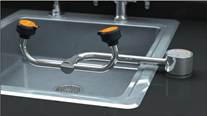
3. Deck-mounted eyewash station top pick: Guardian Equipment G1805 Eyewash
Price range: $312.73 to $504.40
This emergency eyewash station has a patented technology that allows it to activate by positioning the spray head horizontally over the sink. The water that flows out is typically clean, thanks to the integral filter, flow control and dust covers. This unit is especially useful in small spaces, since the unit is easily installed beside an ordinary sink.
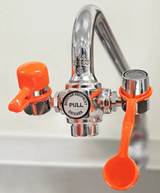
4. Faucet-mounted eyewash station top pick: Uline BL 880 Faucet Mount Eyewash Station
Price range: $100.00 to $105.00
This unit can turn any standard faucet into an emergency eyewash station. No special tools or additional plumbing are required for installation, making it ideal for workplaces that need flexible safety solutions.
The eyewash unit is activated with an easy-pull knob and features flip-top dust covers to ensure cleanliness. Its simple design and functionality make this a cost-effective choice for adding emergency features without the need for complex renovations.
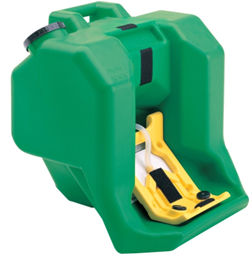
5. Gravity-fed portable eyewash station top pick: Haws 7500 Portable Eyewash Station
Price range: $439.56 to $499.95
With its 16-gallon capacity, the Haws 7500 meets the ANSI Z358.1-2014 requirements for ample flushing at a steady pressure. The unit has a durable, high-density polyethylene tank and ABS plastic eyewash heads that produce the required 0.4 GPM flow rate over 15 minutes.
The Haws 7500 is activated with a yellow pull-down arm. Its portable design is made with integral handles and a wide opening for easy maintenance and refilling. This model is ideal for remote and low-traffic areas that require dependable emergency eyewash capabilities.
6. Speakman SE-4400 Portable Emergency Eye Wash Station
Price: $295.12
Speakman is a brand recognized for its quality commercial plumbing. This model suits industrial environments where permanent plumbing is not feasible, such as construction sites.
The portability of this model allows for flexible installment options, ensuring that workers have access to emergency eyewash facilities in even remote worksites. The unit’s activation tray enables wall-mounting, tabletop mounting, or even on vehicles. The Speakman portable eyewash station conforms with OSHA and ANSI/ISEA Z358.1 requirements. It provides at least 15 minutes of eye flushing with tepid water.
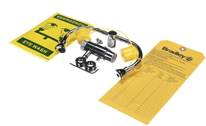
7. Bradley Sink Faucet Mount Eyewash
Price: $144
This faucet-mounted eyewash from Bradley fits easily into most existing sink setups. This unit meets ANSI Z358.1 standards. It comes in a space-saving design.
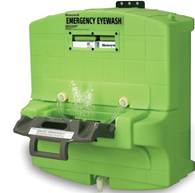
8. Honeywell Fendall Pure Flow 1000 Eyewash Station
Price: $885.98
The Honeywell Fendall Pure Flow 1000 is designed for worksites that have constant hazards. It delivers 15 minutes of uninterrupted flow of pH-balanced saline solution. The product meets ANSI standards with a flow rate of 0.4 GPM (1.5 L). The main advantage of this model is that it uses quick-change, 3.5-gallon cartridges, offering safe, uncontaminated eye-washing that’s better than using tap water. Its other benefits include portability, no need for existing plumbing, and ease of maintenance.
.jpeg)
9. Dynamic 16-Gallon Gravity Eyewash Station
Price range: $479.71 to $560.70
This 16-Gallon Gravity Eyewash Station from Dynamic is a self-contained system that delivers cleansing water via dual spray heads in emergencies. The unit is a gravity-fed system, making it work independently of any plumbing and ideal for use in remote worksites or locations. Its ease of installation and use makes it convenient and easy to deploy in emergencies.
The unit itself has a steel mounting bracket for wall installation, but it can also be used as a tabletop unit. This eyewash station is compliant with ANSI Z358.1. The unit comes completely assembled and with an 8-oz bottle of bacteriostatic additive to ensure the eyewash is free of any contaminants.
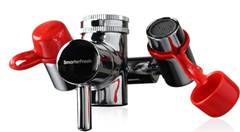
10. SmarterFresh Faucet Mounted Eyewash Station
Price: $269.44
As with many other faucet-mounted eyewash stations, the SmarterFresh Faucet Mounted Eyewash Station is convenient to add to emergency eyewash facilities to existing faucets. This unit is ideal for a variety of worksites and settings where eye injuries or contaminants have a high likelihood of occurring.
This emergency eyewash station suits industrial worksites, small offices, or labs. Made from high-quality materials, the SmarterFresh faucet mounted unit can be easily installed without complex installation procedures or impeding basic faucet functions.
For other eyewash station options, visit our page on emergency showers and eyewash.
What are the different types of eyewash stations?
Eyewash stations are an important part of a company or organization's workplace safety measures. They make up part of the safety infrastructure and personal protective equipment (PPE) for employees. These stations are essential for employees if they deal with hazardous chemicals or other substances that may cause serious eye injuries. There are generally two main types of eyewash stations:
1. Plumbed eyewashes
As the name suggests, these eyewash stations are connected to a building’s plumbing system. To function effectively, plumbed eyewashes are connected to a source of potable water and drainage. These eyewash stations can be further divided into several types:
Wall-mounted
This type may or may not have a bowl and, like a sink, is mounted on walls.
Floor-mounted
This plumbed eyewash station is on a pedestal and may drain straight to the building’s plumbing or to a drain on the floor.
Deck-mounted
Deck-mounted eyewashes are another form of plumbed eyewash station, usually placed right next to a sink. To use deck-mounted eyewash stations, it can have a swing arm that is positioned over the sink basin or have a dual-headed drench hose that can be extended by the user.
Faucet-mounted
This type of eyewash station is connected to an existing faucet, draining into a sink. Since this is not typically temperature-controlled nor does it have sufficient pressure to deploy in a second or less, it's considered as a supplemental eyewash. If it has insufficient pressure, faucet-mounted stations must be replaced by or used with other eyewash stations.
Eyewash stations are crucial safety features in water plants, but their maintenance and correct usage often go unnoticed. Are you aware of the essential maintenance practices and proper procedures? pic.twitter.com/NmI38jidhq
— Water Movement (@water_movement_) June 29, 2023
2. Portable eyewash station
This category of eyewash stations consists of units not connected to a building or facility’s plumbing system. These stations have independent water supplies or use flushing fluid instead of water to wash away contaminants from the eyes. The different types of portable eyewash stations include:
Self-contained eyewash
This portable eyewash has its own reservoir of flushing fluid. Generally, self-contained eyewash stations have their flushing fluid reservoir suspended, using gravity to feed the eyewash heads.
Mounted on a wall, these self-contained units must be able to deploy tepid flushing fluid at a speed and volume of 0.4 gallon per minute (GPM) for at least 15 minutes. This is important, as this capability is required for this type of station to be deemed OSHA-compliant.
Squeeze bottle eyewash
This portable eyewash is simply a plastic bottle filled with a buffered saline solution. Saline solutions expire and should be replaced according to the manufacturer’s recommended schedule. If water is used instead of a saline solution, the water must be changed weekly.
Key features to consider in eyewash stations
Your company and staff should not settle on just any sort of eyewash stations. These must be compliant with standards set by the Canadian Centre for Occupational Health and Safety (CCOHS) and the Occupational Safety and Health Administration (OSHA). Right now, there is no Canadian standard for the design of eyewash stations. Your staff can refer instead to the American National Standards Institute (ANSI) Standard Z358.1-2014 (R2020) for the specifications and requirements for emergency eyewash and shower equipment.
Here are some of the most important OSHA requirements to consider when choosing and installing your eyewash stations:
- Eyewash stations must be within a 17-metre (55-foot) radius or reachable within ten seconds of walking away from the potential workplace hazard.
- The station must be on the same level as the hazard with no obstruction; no steps, ladders, or any obstacles should impede or delay access to the station.
- The station must provide a flow of flushing liquid or water that does not harm the eyes. The flow must also last long enough to let users continue flushing for at least 15 minutes.
- The area around the eyewash station must be clearly marked and sufficiently lit.
- The height of the station should accommodate most people regardless of height; the station should be between 33 and 45 inches from the floor.
Eyewash station compliance requirements
According to the CCOHS, management and relevant staff of your organization should consult the occupational health and safety agency in your jurisdiction. This is important to ensure that your organization conforms with the local legislation on occupational health and safety in general and eyewash stations in particular.
As of now, there is no Canada-wide standard for the design, placement, or use of eyewash stations or emergency showers. However, Ontario has mandated Regulations for Industrial Establishments (O.Reg.851) under their own Occupational Health and Safety Act.
Many Canadian organizations are also encouraged to apply the ANSI Z358.1-2014 (R2020) "Emergency Eyewash and Shower Equipment" as a guide.
Eyewash station installation tips
There can be a long process involved in installing eyewash stations at your worksite. It’s advisable to contact and consult the best safety experts and help you find the best eyewash stations for your company’s needs. These safety contractors and consultants should be sufficiently qualified to ensure that you choose from stations that fulfill the ANSI Z358.1-2014 (R2020) Standard.
Maintenance and testing of eyewash stations
Maintaining your eyewash stations is necessary to ensure that your staff always have sufficient water flow. They should be always ready to flush in case of an emergency. To maintain your wash stations, do weekly checks of the water pressure to ensure proper function.
If plumbed, let the wash station’s water run through the spray heads to flush out any sediment and stagnant water.
For gravity-fed stations, these wash stations require changing the water every three to six months. Read the manufacturer's instructions for additional upkeep and safety tips.
Testing and maintenance procedure for plumbed eyewash stations
Here are the standard steps for testing and maintaining plumbed eyewash stations:
- Visually inspect the unit. Check for any damage or corrosion to parts of the unit, like the hose, nozzles or spray heads, and protective lids. Observe if there are any leaks and make sure the unit is clear of any obstructions or obstacles.
- Provide a catchment for the water or flushing liquid. If the unit is not connected to a drain, place supplies under or around the eyewash to catch any outflowing water or flushing liquid. You can use an empty tub, large bucket, or large trash bag.
- Turn on the eyewash station. To ensure that the station works properly, test the station at full strength.
- Flush out impurities and stagnant water. Allow the station to run its water, then check if the water flow is clear and sputter-free. Let the water run for an extra 30 to 60 seconds to flush out debris or impurities in the system.
- Turn off the eyewash. If not connected to a drain, be sure to collect the water and pour it into a sink drain. Clean up water that may have splattered or spilled on the floors and walls.
- If found to be damaged, replace protective caps.
- Take note of any functional defects. Contact your supplier to make the necessary repairs or replacement of parts. Some of the defects can include:
- uneven water flow; too weak or too strong
- incorrect water temperature; the temperature range ideally should be between 60°F and 100°F (between 15.5°C and 38°C)
- water does not run clear
Make sure that your company’s safety personnel sign the testing record with their initials, or signature, and mark down the date of inspection.
Testing and maintenance of non-plumbed eyewash systems
As for the inspection, upkeep and testing of independent, non-plumbed systems, here are the steps:
- Inspect the unit thoroughly. Look for damage to the parts, corrosion, and leaks. Make sure that the eyewash unit is not obstructed and easily accessible.
- Replenish or replace the flushing liquid if necessary. Flushing fluids, like buffered saline solutions, have expiration dates. Check the expiration dates on the unit and replace the fluid as needed. If no expiration dates are indicated, replace the fluid at least once a year.
- Follow other instructions from the manufacturer. Refer to the manufacturer’s operating manual for any other maintenance instructions or procedures.
- Record the inspection and maintenance procedure. Log the date and time when the inspection and maintenance process was done. Be sure to have the relevant personnel sign the log and record the date.
Guidelines for using eyewash stations
Fortunately, workplace incidents that affect the eyes are few and far between, but it helps to be aware and know how to use an eyewash station should the need arise. In case of emergency, here are useful tips for using an eyewash station:
Don’t delay or hesitate to use the station
If you suspect a small spill or hazard entered one or both eyes, do not hesitate or delay using the eyewash station. Ideally, the station must be located within a ten-second walk away from any hazardous substance or materials in your worksite.
Remove contact lenses
If you wear contact lenses, remove them only when you’ve begun flushing out your eyes.
Concentrate on flushing your eyes
Once activated, the eyewash station should continuously discharge water without further manipulation on the user’s part. Use your fingers to keep your eyelids open, then lower your eyes to the water coming out of the nozzles. Gently roll your eyes from side to side, and up and down.
Don’t stop flushing
Continue to flush out your eyes for at least 15 minutes, rolling your eyes and making sure that the water reaches every part of your eyeballs. This is the minimum time it takes to completely flush chemicals out of your eyes, so don’t stop flushing until the 15 minutes are up. Taking less time may not flush out the chemicals and lead to permanent eye damage.
Get medical assistance
After completing the flushing, seek medical attention immediately. Have a work colleague take you to the nearest hospital; do not risk going yourself as your vision may become impaired.
Here’s a video on what to do in case of an emergency where using an eyewash station is warranted. While the video is of eye contamination in a laboratory setting, this can apply in industrial worksites as well:
Visit our Product Resources page for more news and information about workplace safety equipment and devices in Canada.
The importance of eyewash stations
Eyewash stations are an important part of workplace safety, especially in industries and environments that can potentially result in serious eye injuries. In fact, according to the CCOHS, at least 200 people in Canada get a work-related eye injury every day.
Failing to take protective or emergency measures and train workers in their use not only results in high medical costs, but also affects employees’ morale. This can sometimes result in hefty fines. Once your eyewash stations are installed, inform and train employees on their location and use.
Which of the eyewash stations we featured are you thinking of purchasing for your workplace? Let us know in the comments below


